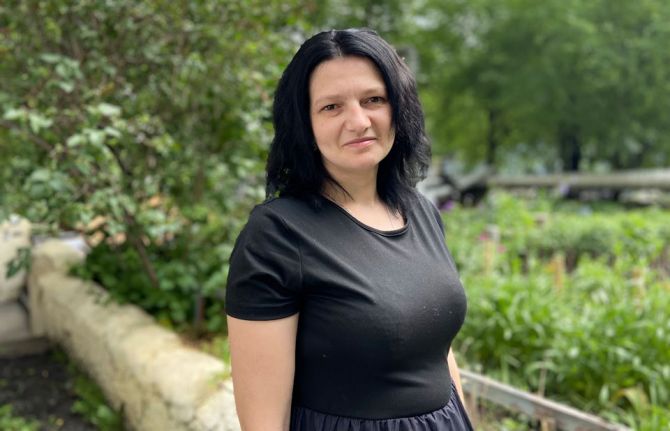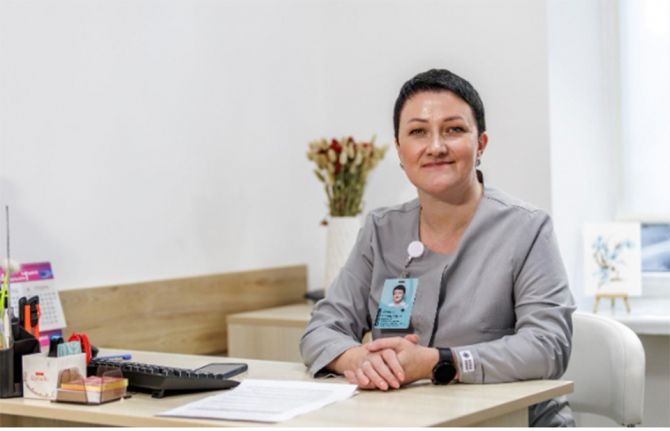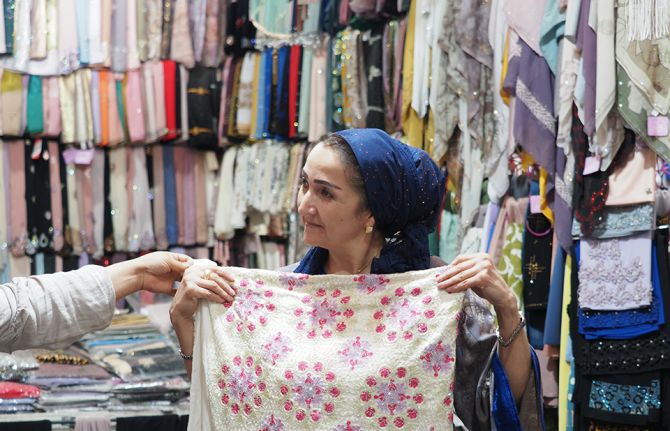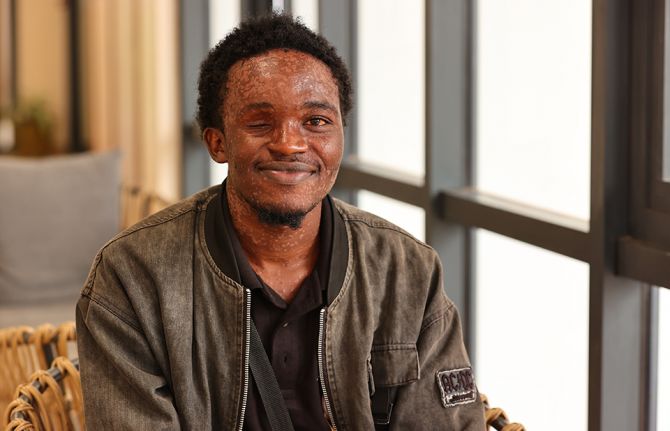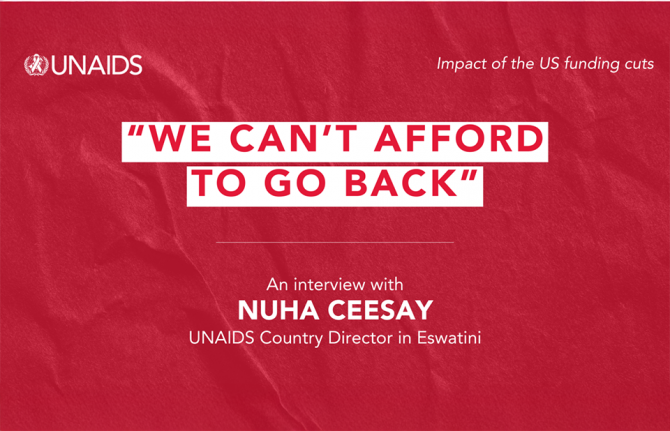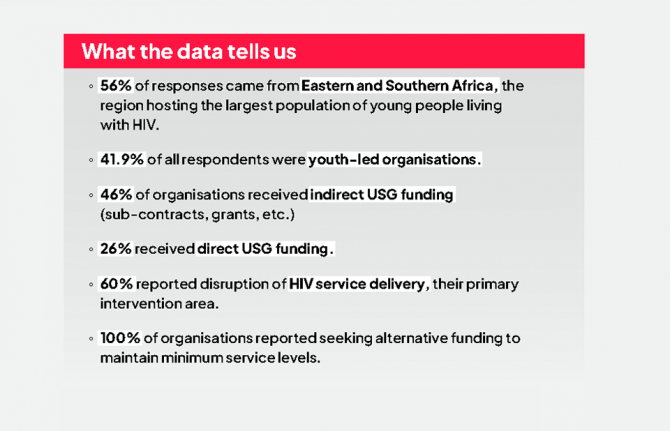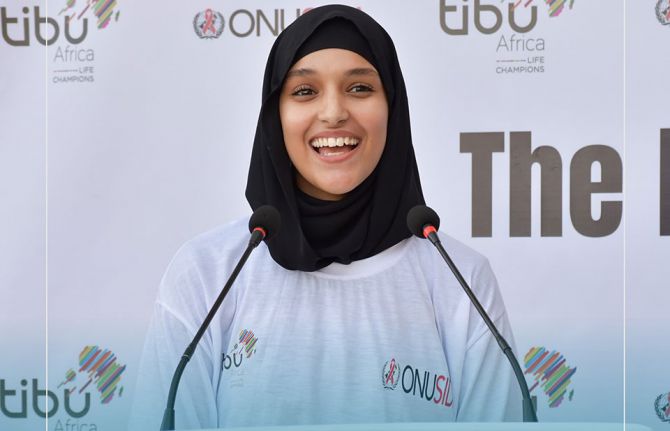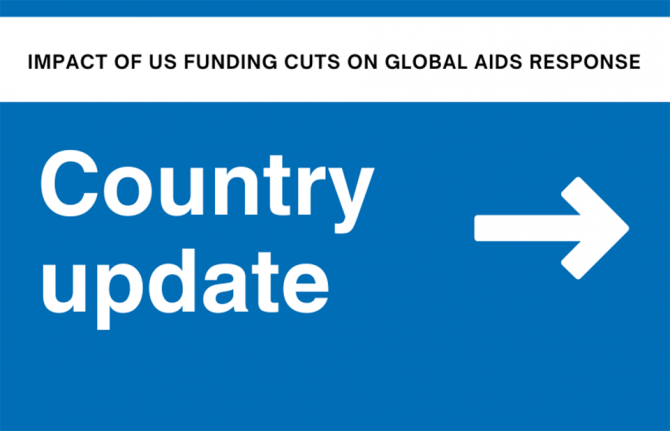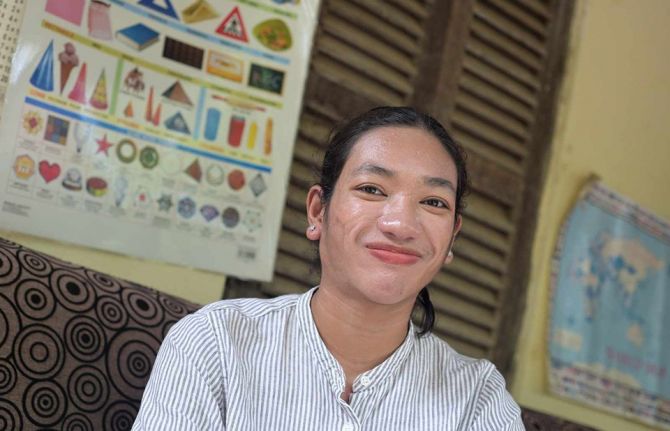
Feature Story
MDG-6 Forum addresses challenges faced by women and girls affected by HIV in Eastern Europe and Central Asia
13 October 2011
13 October 2011 13 October 2011
Panellists in the session included (from left to right): Nina Ferencic of UNICEF; Paige Alexander of USAID; James Chau, a UNAIDS Goodwill Ambassador; Mikhail Grishankov, a member of Russia’s State Duma; Dr Luiz Loures, Director of the UNAIDS Executive Office
Women, girls and HIV were the focus of a panel discussion on the final day of the International Forum on MDG-6 in Eastern Europe and Central Asia. Moderated by UNAIDS Goodwill Ambassador James Chau, the session included representatives from government, civil society and international development organizations.
Across Eastern Europe and Central Asia, the number of women infected with HIV is growing every year. In Russia, HIV prevalence among young women aged 15-24 is two times higher than among men of the same age, according to government figures.
Alexandra Volgina, an advocate for the Russian women’s network EVA, opened the session describing the key challenges faced by women and girls affected by HIV in the region. Stigma and discrimination, she said, continue to hamper access to HIV services and sustained availability of HIV treatment remains a major concern. Harm reduction programmes for women who inject drugs are insufficient, she added.
Ms Volgina was joined in the audience by women affected by HIV from across the region. Svetlana, a former drug user and mother of two, called for programmes that address the specific needs of women, including special treatment and care centres for women with children. “The birth of a child is a huge incentive for women using drugs to quit—but when these women seek help, we have nothing to offer,” she said.
Members of the regional networks highlighted the issue of violence faced by women within their own homes and communities. They also spoke of the pressure that many pregnant women living with HIV face to end their pregnancies. Several participants indicated that legal frameworks hinder access to much-needed care, including services that prevent new HIV infections in newborns.
Without political leadership and a united civil society, we will not be able to move ahead on this issue
Mikhail Grishankov, member of Russia’s State Duma and a longstanding advocate for women and girls
Women affected by HIV launched a campaign at the MDG-6 Forum with the slogan, “Children’s health starts from mom! Invest in women!” This theme was echoed in the remarks of UNICEF’s Nina Ferencic, who drew attention to the inextricable link between mother and child. “If you ask HIV-positive children what they want, they’ll tell you that—more than anything—it’s for their mothers to be alive and well. For a child to be healthy and happy, we need to first take care of the mother,” she said.
Panelist Paige Alexander of the U.S. Agency for International Development (USAID) said that putting a human face to HIV is what will drive change in the region. “We need to raise the face of women through all channels—by, for example, supporting women’s networks and women’s leadership,” she said.
Mikhail Grishankov, a member of the Russian Federation Parliament who has been working on AIDS issues for many years and a longstanding advocate for women and girls, called for greater cooperation between all stakeholders in addressing the needs of women in the HIV response. “Without political leadership and a united civil society, we will not be able to move ahead on this issue,” said Mr Grishankov, who also serves as Vice-Chair of an inter-parliamentary working group on AIDS and other diseases.

Sveta Izambaeva, member of the Russian Network of Women affected by HIV
Mr Grishankov also underscored the need for wider public awareness of HIV in Russia using various media channels. He committed to organizing a highly visible follow-up meeting between parliamentarians, women’s groups and HIV experts to review the immediate challenges faced by women affected by HIV in obtaining appropriate services.
“We need a fundamental change in the way that this region is responding to HIV,” said Luiz Loures, Director of the UNAIDS Executive Office. “If we want to make progress in this region, we need to look at the epidemic through a woman’s eyes,” concluded Dr Loures.
The International Forum on MDG-6, hosted in Moscow from 10-12 October by the Russian Federation, aimed to foster a strategic discussion on progress towards the Millennium Development Goal 6 in Eastern Europe and Central Asia. UNAIDS will ensure immediate follow-up to the Forum, engaging women’s organizations and partners.
Publications
Related

Feature Story
UNAIDS Goodwill Ambassadors shine spotlight on HIV in BRICS countries and beyond
12 October 2011
12 October 2011 12 October 2011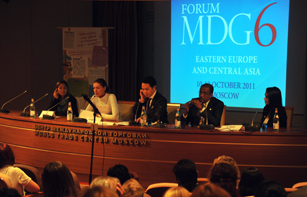
Panellists in the session included (from left to right): Women’s World Cup champion Lorrie Fair; Russian HIV activist Alexandra Volgina; Chinese television news anchor James Chau; UNAIDS Executive Director Michel Sidibé; and Indian actress Preity Zinta.
On the opening day of the International Forum on MDG-6 in Moscow, Indian actress Preity Zinta, women’s World Cup champion Lorrie Fair, Russian HIV activist Alexandra Volgina and UNAIDS Executive Director Michel Sidibé engaged in a lively discussion on how to turn the Millennium Development Goal 6 (MDG-6) into reality. The panel session, moderated by Chinese television news anchor James Chau, highlighted the important contribution by BRICS countries to the HIV response, and also the challenges ahead to achieve an AIDS-free generation.
Brazil, Russia, India, China and South Africa—often referred to as the “BRICS” countries—are home to 40% of the global population and nearly one third of all people living with HIV in the world. While all BRICS countries have made progress in expanding HIV prevention and treatment services for their populations, the goal of universal access remains a critical challenge: In four of five BRICS countries, for example, only one third of people eligible for HIV treatment are receiving it.
With Eastern Europe and Central Asia facing a significant number of new HIV infections among people who inject drugs, Mr Chau, a UNAIDS Goodwill Ambassador, highlighted China’s national achievements in expanding harm reduction services. “Last week, I visited a methadone maintenance therapy clinic and saw first-hand how access to harm reduction is changing lives,” he said. Mr Chau noted that after years of a zero tolerance policy on injecting drug use, China began its harm reduction programme in 2005 and now has more than 700 clinics offering methadone maintenance therapy.
In India, the film industry has incredible influence and reach. So does cricket—the most popular sport in my country. If we succeed in using both mediums to spread awareness around HIV prevention, we will not just have healthier populations, but more caring ones too
Preity Zinta, actress and UNAIDS Goodwill Ambassador
A supporter of social equality, Ms Zinta, who is also a Goodwill Ambassador for UNAIDS, cited the sports and film industries as important platforms to reach people of all ages with HIV prevention messages. “In India, the film industry has incredible influence and reach. So does cricket—the most popular sport in my country. If we succeed in using both mediums to spread awareness around HIV prevention, we will not just have healthier populations, but more caring ones too,” she said.
Ms Volgina, an advocate for the women’s network EVA, shared a personal story of the stigma she has faced as a woman living with HIV. “I have a goal to try and change HIV policy in Russia, so that when children impacted by AIDS—like my own daughter—reach school age, they won’t be discriminated against in any way,” said Ms Volgina, who recently gave birth to an HIV-negative baby. Ms Volgina highlighted how the HIV epidemic in the Russian Federation continues to grow, and increasingly affects women.

UNAIDS Executive Director Michel Sidibé and Indian actress and UNAIDS Goodwill Ambassador for India Preity Zinta
Ms Fair brought the discussion to South Africa, where she is currently working for the Charlize Theron Africa Outreach Project in the rural area of Kwa-Zulu Natal. Her work supports the use of mobile health units to provide HIV treatment, testing and counselling, education, and basic health care for communities spread out over great distances. “Bringing these services directly to people who need them is an important strategy to curb the HIV epidemic—not only in South Africa, but in any place where people would otherwise not have access,” said Ms Fair.
The UNAIDS Executive Director Michel Sidibé emphasized that people—not data or statistics—must be at the centre of efforts to reach MDG-6. “What inspires and guides my work are women like Alexandra who are breaking new ground in the AIDS response in Russia,” said Mr Sidibé. Achieving the UNAIDS vision of Zero new HIV infections, Zero discrimination and Zero AIDS-related deaths is “entirely possible” in Russia and beyond, he said.
The International Forum on MDG-6 is a three-day meeting hosted by the Russian Federation in collaboration with UNAIDS, the World Bank and the Global Fund to Fight AIDS, Tuberculosis and Malaria. Its aim is to foster a strategic discussion among key stakeholders on how to mobilize resources and partnerships to achieve MDG-6.
Related

Feature Story
Russian Federation convenes high level forum on MDG-6
11 October 2011
11 October 2011 11 October 2011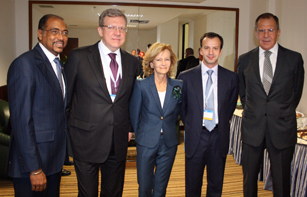
Panelists at the opening of the MDG-6 Forum including (left to right): Michel Sidibé, UNAIDS Executive Director; Alexey Kudrin, Governor of the World Bank Group and the IMF for the Russian Federation; Elena Salgado, First Vice President, Government of Spain; Arkady Dvorkovich, Aide to the President of the Russian Federation and Chair of the MDG-6 Forum; Sergey Lavrov, Minister of Foreign Affairs, Russian Federation.
On the opening day of the International Forum on MDG-6 in Eastern Europe and Central Asia, the three international Co-chairs of the meeting—UNAIDS, World Bank, and the Global Fund to Fight AIDS, Tuberculosis and Malaria—unveiled a new joint statement calling for accelerated action on MDG-6 in the region.
The three-day meeting in Moscow, hosted by the Government of the Russian Federation, brought together high-level representatives from government, civil society, the private sector and scientific community. The Forum is an unprecedented platform to redouble progress towards the sixth Millennium Development Goal (MDG) in the region.
MDG-6—one of eight development goals adopted by world leaders in 2000—calls for halting and reversing the spread of HIV, malaria, tuberculosis and other diseases by 2015. While the countries of Eastern Europe and Central Asia are on track to reach several of the MDGs, progress on MDG-6 is generally seen as behind.
Speaking at opening plenary on 10 October, Arkady Dvorkovich, Aide to the President of the Russian Federation and Chair of the MDG-6 Forum, underscored the critical link between achieving MDG-6, economic growth and sustainable development. “Russia has always considered fighting infectious diseases to be a priority for development. In view of the current economic situation, it has never been more important to ensure that our results are sustained and that commitments are kept,” he said.
Sergey Lavrov, Russia’s Minister of Foreign Affairs said that Russia’s development assistance strategy in the region includes programmes related to HIV and other infectious diseases. “The health of all people in all times has been the most important asset for any state—that is why our work on HIV is so important,” he said.
Since the G8 Summit in St Petersburg in 2006, Eastern Europe and Central Asia has made significant progress in its response to HIV—one of the main pillars of MDG-6. Across the region, more than 90% of pregnant women living with HIV now receive services to prevent new HIV infections in their children.
Access to antiretroviral therapy has also expanded rapidly. In the Russian Federation, nearly
80 000 people were receiving life-saving antiretroviral therapy in 2010, compared to just 5,000 people in 2005—a sixteen-fold increase.
Experience and science have shown us that without a holistic approach to the HIV response—including harm reduction and substitution therapy—we will not stop the transmission of HIV
UNAIDS Executive Director Michel Sidibé
Despite progress, Eastern Europe and Central has the fastest-growing epidemic in the world. Over the past decade, the number of people living with HIV in the region has nearly tripled, from 530 000 in 2000 to 1.4 million in 2009. Approximately half of all new HIV infections in the region result from injecting drug use.
“Experience and science have shown us that without a holistic approach to the HIV response—including harm reduction and substitution therapy—we will not stop the transmission of HIV,” said UNAIDS Executive Director Michel Sidibé, in his opening address at the Forum. “Inaction will be very costly—if we don’t pay now, we will pay forever.”
Elena Salgado, First Vice President of Spain, also underscored the importance of harm reduction programmes in preventing HIV transmission among people who use drugs. In recent years, Spain has adopted a pragmatic—rather than moral—approach to injecting drug use which has led to a steep decline in new HIV infections, she said.
A new MDG-6 Action Plan will be launched on the final day of Forum, with an emphasis on financing and regional partnerships. The plan provides a road map to achieve a 50% reduction in new HIV infections across the region, among other goals.
Related

Feature Story
Russian government and UNAIDS face off in charity soccer match
10 October 2011
10 October 2011 10 October 2011
Arkady Dvorkovich, Aide to the President of the Russian Federation (pictured left) and UNAIDS Executive Director Michel Sidibé deliver short remarks before a charity soccer match in Moscow on 9 October.
On the eve of the International Forum on Millennium Development Goal (MDG)-6, the Government of the Russian Federation and the Joint United Nations Programme on HIV/AIDS (UNAIDS) co-organized a charity soccer match at the Luzhniki Olympic Stadium in Moscow in support of women and children living with HIV in Russia.
The two teams—captained by Arkady Dvorkovich, Aide to the President of the Russian Federation, and Michel Sidibé, UNAIDS Executive Director—were composed of prominent politicians, business leaders and former international and Russian sports stars.
Members of the UNAIDS Red Ribbon United Team included internationally-known soccer players Daniele Massaro, Luigi Di Biagio, Gianfranco Zola and Lorrie Fair. A number of high level government officials joined Dvorkovich on the Russian Rossich Team, including Sergey Lavrov, the Minister of Foreign Affairs, and Alexander Zhukov, Deputy Prime Minister.
I hope this event will encourage governments and companies to join efforts to support women, children and families affected by HIV
Arkady Dvorkovich, Aide to the President of the Russian Federation
“The aim of this game is to bring attention to the issue of HIV,” said Mr Dvorkovich. “I hope this event will encourage governments and companies to join efforts to support women, children and families affected by HIV,” he added.
Thanking the Russian Government for taking the lead in hosting the match, the UNAIDS Executive Director noted: “This is not just a game—I am confident that this event will help break the upward trajectory of the HIV epidemic in the region.”
According to government figures, a growing proportion of women across Eastern Europe and Central Asia are living with HIV. In Russia, HIV prevalence among young women is two times higher than among than among young men. Throughout the region, stigma and discrimination prevent women and children from accessing much-needed HIV and other health services.

The two teams—captained by Arkady Dvorkovich, Aide to the President of the Russian Federation, and Michel Sidibé, UNAIDS Executive Director—were composed of prominent politicians, business leaders and former international and Russian sports stars.
Speaking on behalf of women living with HIV in the region, Alexandra Volgina, an advocate for the Women’s Network EVA said, “This is the first time that we have come together in this region to talk about HIV at such a high level. I hope that we can all join forces to ensure that political declarations of commitment become a reality on the ground.”
Donations collected during and after the match will be used to finance a project in St Petersburg that helps women, children and families affected by HIV. On World AIDS Day, UNAIDS will publicly announce the results of the fundraising campaign.
This week, the Government of the Russian Federation, UNAIDS and partners will co-host an International Forum on MDG-6—a high-level meeting of representatives from government, civil society, the private sector and scientific community. The aim of the Forum is to foster discussion on progress towards MDG-6, with a specific focus on financing and regional partnerships in Eastern Europe and Central Asia.
MDG-6—one of eight development goals adopted by world leaders in the year 2000 at the United Nations in New York—calls for halting and reversing the spread of HIV, malaria, tuberculosis and other diseases by 2015.
Related

Feature Story
UNAIDS Executive Director visits pioneering HIV clinic near St Petersburg
10 October 2011
10 October 2011 10 October 2011
UNAIDS Executive Director Michel Sidibé (left) plays with a two-year-old boy at a specialized centre for children living with HIV near St Petersburg, Russia.
On the first of a four-day mission to the Russian Federation, UNAIDS Executive Director Michel Sidibé and UNAIDS Goodwill Ambassador James Chau visited a specialized HIV clinic near Saint Petersburg that cares for children who have been orphaned by AIDS and pregnant women living with HIV. The UNAIDS delegation toured the facility with its chief physician, Dr Evegeny Voronin, a leading AIDS expert in Russia.
“We receive children from all over Russia—mainly, the most severe cases of HIV infection,” said Dr Voronin, head of the Centre for Prevention and Treatment of HIV Infection in Pregnant Women and Children. “The overall strategy is that children are treated in their place of residence and sent to us only when there is no other choice,” he added.
Providing high quality treatment is just half the battle, says Dr Voronin. After addressing a child’s medical needs, he and his team of social workers turn their attention to the social and psychological environment—crucial elements in the health and development of any child, particularly one living with HIV.
“Here at the Centre, we try to do everything we can so that the children don’t feel different from children in families,” said Dr Voronin, adding that his team encourages the children to dance, play music and participate in group activities to help them become more socially engaged. “But this Centre will never be a substitute for a real family,” he said.
Here at the Centre, we try to do everything we can so that the children don’t feel different from children in families. But this Centre will never be a substitute for a real family
Dr Evegeny Voronin, head of the Centre for Prevention and Treatment of HIV Infection in Pregnant Women and Children
During their tour of the Centre, Mr Sidibé and James Chau were treated to a musical performance by five pre-school age girls and one male toddler. “Being here gives me great hope,” said the UNAIDS Executive Director. “When they first came to this Centre, many of the children were unwell and couldn’t speak. Now they are dancing, singing, healthy and thriving,” he said.
According to government statistics, an estimated 5200 children under the age of 15 were living with HIV in the Russian Federation in 2010. More than 22% of children living with HIV are orphans or have been left behind without parental care.
Perceptions around HIV slowly shift
Dr Voronin notes that in Russia’s larger cities, social stigma towards people living with HIV is less pronounced than in remote regions of the country, as people tend to have access to more information. “Here in St Petersburg, HIV is not a rare disease—there are more than 40 000 people living with HIV,” he told the UNAIDS delegation. “People recognize that HIV-positive people are the same as everyone else.”
As HIV becomes more widely understood and accepted in Russia, the number of adoptions of children living with HIV is on the rise, says Dr Voronin. Five years ago, he says, only 10 out of 350 abandoned children were adopted in Russia—mainly by employees at his Centre or people of religious faith. Today, 100 per cent of girls under the age of seven at the Centre are adopted by families.
“These children are sons and daughters,” said James Chau, a well known television personality in China who works with UNAIDS on stigma and discrimination issues. “If we succeed in breaking the last barrier—social stigma—we will turn a fundamental corner in the HIV response. I am incredibly encouraged by what I see at Dr Voronin’s Centre.”
Preventing new HIV infections in children
In addition to caring for children living with HIV, the centre works to prevent new HIV infections. “Over the past two years, we have achieved zero per cent transmission of HIV from mother to child among 300 women seen at our centre,” said Dr Voronin.
He noted, however, that about 15% of pregnant women living with HIV across Russia seek treatment too late in their pregnancies—immediately before or during labor—and give birth to about 50% of all HIV-positive children in the country.
Related

Feature Story
Building knowledge, skills and hope in southern Africa’s schools
07 October 2011
07 October 2011 07 October 2011
Learners participating in a ‘Positive Speaking’ intervention, in Luanda, Angola
Credit: UNESCO
Students and teachers in four southern African countries are benefiting from an ambitious HIV programme spearheaded by UNESCO. From its start in 2008, the programme was designed to strengthen the education sector’s AIDS response in Angola, Lesotho, Namibia and Swaziland.
Called ‘Building knowledge, skills and hope: HIV and AIDS education for African children’, the three-year project has encompassed improving the curriculum and learning materials about HIV. It has also focused on supporting teacher training with better programme and policy guidance. The programme aimed to strengthen care and support systems for learners and education personnel affected by HIV as well as to improve the delivery of AIDS education in hundreds of schools.
Implemented by UNESCO and financed by the Virginio Bruni Tedeschi Foundation, the project was carried out under the UNAIDS Global Initiative on Education and HIV and AIDS (EDUCAIDS) and reinforced ongoing work in each country’s ministry of education.
According to UNESCO the result has been the repositioning of the education sector at the centre of the national AIDS response in all four countries. Reforms are underway in all project countries to integrate HIV and sexuality education into the curricula of schools and teacher training institutions.
The initiative has led to a number of innovations such as the establishment of the first national networks of teachers affected by HIV. “Since this initiative was launched, we share our experiences, our fears, our hopes and our dreams together,” said Nelao Martin, a teacher living with HIV and a member of the EduSector Support Network on Health and HIV in Namibia. “In the past, someone somewhere has necessarily been through the same difficulties and managed to deal with it.”
Since this initiative was launched, we share our experiences, our fears, our hopes and our dreams together. In the past, someone somewhere has necessarily been through the same difficulties and managed to deal with it.
Nelao Martin, a teacher living with HIV and a member of a national network of teachers affected by the virus in Namibia
The first support groups for children and adolescents affected by AIDS have been established. Also, in partnership with associations of people living with HIV, new approaches have been used to reach out to positive learners in schools. ‘Positive Speaking’ sessions were introduced whereby personal testimonies and experiences of young, openly HIV-positive facilitators allowed pupils to ‘put a face’ to the virus.
Nkuebe Peete, an HIV-positive 23 year-old living in Lesotho has taken part in such interventions: “I am proud to share my story and experience with younger people so that they do not make the same mistakes that I made and become supportive to those who live with HIV. This has given a new meaning to my life. I now have the feeling of being a much better person than before.”
In addition, innovative teaching and learning materials have been developed such as the series of speaking books on HIV for primary pupils in Swaziland. Most materials for the sensitization of older students have been developed by the learners themselves in creative and interactive ways. One particular approach involved national and regional ‘PhotoVoice’ exhibitions which highlighted testimonies of HIV-positive learners and teachers. In total, project activities have reached more than 4 000 schools, 17 000 teachers and nearly half a million learners.
Building on the groundwork laid by the project new initiatives are being developed. For example, in May 2011 Namibia’s ministry of education mandated and budgeted for the introduction of full-time teachers dedicated solely to life skills education, guidance and counselling in all primary and secondary schools.
Lesotho and Swaziland are about to adopt policies that recognize the impact of AIDS on their education systems. Such policies call for the integration of strategies for prevention and care adapted to the needs of learners and teachers. Similar efforts have been initiated in Angola, which is addressing the formulation of an education sector strategy and policy on HIV.
Project partners believe the programme has contributed significantly to improving the AIDS response in the education sectors in all four countries. According to Majoele Likonelo Hlasoa, Director of Planning at the Ministry of Education and Training in Lesotho, “When I first joined the Ministry of Education, I did not understand what the education sector could and should do about HIV, which I considered then as a health issue falling fully under the responsibility of the Ministry of Health. Since I have been exposed to the EDUCAIDS framework for action, I have changed my mind and have a real understanding of the issues at stake.”
External links
External links
Publications

Feature Story
UNAIDS welcomes Haitao Gong, this year’s Serge Dumont-Fudan Strategic Communications Research Fellowship winner
05 October 2011
05 October 2011 05 October 2011
Haitao Gong, Serge Dumont-Fudan Strategic Communications Research Fellowship winner, working at UNAIDS HQ. Geneva, 05 October 2011.
Credit: UNAIDS
UNAIDS extends a warm welcome to Haitao Gong, this year’s Serge Dumont-Fudan Strategic Communications Research Fellowship winner. Haitao is pursuing a master’s degree in marketing communications in the prestigious School of Journalism at the University of Fudan in China and joined the UNAIDS communications team as an intern in September. He will be spending the next three months turning his theoretical knowledge into practice in the high-paced environment of the UNAIDS Geneva Secretariat.
UNAIDS.org met up with Haitao to talk about travelling outside China for the first time and what he hopes to gain from this scholarship.
Tell us about the Serge Dumont scholarship that brings you to UNAIDS all the way from China.
I come from Wei Fang, the famous “Kite City”, in Shandong province in the north of China. It’s about 1000 kilometres from Shanghai. Fudan University, where I study, was founded in 1905 and is one of the top five universities in China.
The Serge Dumont-Fudan Strategic Communications Research Fellowship, through which I have obtained this opportunity to intern with UNAIDS, is jointly run by the Serge Dumont Fund and the School of Journalism of Fudan University to encourage outstanding undergraduates and postgraduates committed to a career in strategic communications. It encourages students to apply their theoretical knowledge in practice and get a much deeper insight into strategic communication.
What motivated you to apply for this scholarship?
Initially, I never had the courage to imagine that I would win the scholarship and sit here in the offices of UNAIDS. Winning an opportunity to go abroad and become an intern at a world famous international organization like this was the most significant motivation for me. It is a wonderful and attractive project. I want to give myself the opportunity to improve my skills and apply my knowledge in practice.
Why did you want to come abroad?
I was an excellent student there, but that was only in China. I hope that being here will give me a clear perspective of myself and help me find my own position, not only in China, but also in the world. I wish to broaden my vision, experience different cultures and values and develop an international perspective.
Working for an international organisation such as this can make you think more deeply about making a contribution to the world. And that’s what I want to do
Haitao Gong, Serge Dumont-Fudan Strategic Communications Research Fellowship winner
What did you know about HIV before you came here?
I didn’t know much about it at a personal level. I only knew what I saw in publicity films that it’s a virus that can cause AIDS. In China they also tell us how to prevent HIV and show respect to people living with the virus. There is a big effort in my country to raise awareness about HIV.
What are your career plans after you graduate?
Before I came here, I wanted to work for a big multinational corporation and pursue my own success. But now I think differently. Working for an international organization such as this can make you think more deeply about making a contribution to the world. And that’s what I want to do.
How has your experience been so far?
This is the first time that I’m away from China. I might not be able to adapt as quickly as other Chinese students who have been abroad before. But I am trying my best to adjust to the new environment here and I will spare no effort in making my own contribution to UNAIDS.
The Serge Dumont Fellowship was founded to encourage talented students to pursue careers in strategic communications and public relations. As a strategic partner, UNAIDS offers unique internship opportunities each year where students receive real-world experience in its communication programmes to make their own contribution to the HIV response. So far UNAIDS has hosted three fellows from the programme.
Related
 “Who will protect our young people?”
“Who will protect our young people?”

02 June 2025

Feature Story
Where innovation meets implementation
03 October 2011
03 October 2011 03 October 2011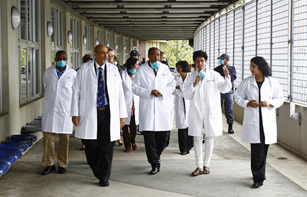
Professor Salim Abdool Karim and his team showing CAPRISA’s Ethekweni research facility to UNAIDS Executive Director Michel Sidibé
In 2010 an announcement was made by the Centre for the AIDS Programme of Research in South Africa (CAPRISA) which rocked the AIDS world and promised hope for millions of women around the world.
The researchers discovered that the antiretroviral medicine tenofovir, when applied to the vagina in gel form, is effective in reducing HIV infections in women by up to 54%.
The discovery was made by Professor Salim Abdool Karim and the team at CAPRISA’s Ethekweni research facility. The centre is located in a historic building built in 1946, originally home to the Durban Chest Clinic, a state-run Tuberculosis facility.
In 2000 the local government built the new state of the art Prince Cyril Zulu Communicable Diseases clinic adjoining the old building which was designed specifically to minimize the risk of cross infection among patients.
It is the largest TB centre of its kind in South Africa, with specially designed ventilation to encourage an in out air flow, vast open waiting areas to reduce the risk of cross infection and huge skylights which enable the suns rays which destroy the TB.
The scientific research being done here gives hope to millions of men, women and children who will lead a longer, healthier life because of these important discoveries
UNAIDS Executive Director Michel Sidibé
The facility is located in central Durban, in the heart of the transport hub for public commuters by rail, bus or minibus taxis.
“This means that the clinic receives a lot of walk-in patients”, explained Santhana Gengiah, Study Coordinator at CAPRISA. “Accessibility and convenience for clients is paramount”.
The venue provided the perfect location for Professor Karim and his team to set up their HIV research programme as the TB clinic which also has a sexually transmitted infection centre on the first floor, found that around 70% of the patients coming into the clinic also were testing positive for HIV.
The CAPRISA eThekwini site comprises two sections, a Treatment Clinic for HIV-TB co-infected patients and an HIV prevention clinic. The prevention section has hosted a number of notable microbicide scientific trials, including the CAPRISA 004 trial and the recently modified Vaginal and Oral Interventions to Control the Epidemic (VOICE) study.

Professor Salim Abdool Karim (left) and UNAIDS Executive Director Michel Sidibé
VOICE is an HIV prevention trial evaluation two antiretroviral based approaches for preventing sexual transmission of HIV in women––daily use of one of two different ARV tablets (tenofovir and Truvada) or of a vaginal gel. The Data and Safety Monitoring Board recommended that VOICE participants in the oral tenofovir arm of the study discontinue their use of the product as the trial was not able to demonstrate that the tablets were effective in preventing HIV in the women enrolled in the trial. VOICE will however continue to test the efficacy of the other oral tablet Truvada and the vaginal gel formulation of tenofovir.
The treatment section of the clinic is perhaps best known for the groundbreaking SAPiT trial, which provided essential evidence for HIV/TB treatment guidelines and informed the current World Health Organization guidelines on the treatment of TB in HIV-positive patients.
The Executive Director of UNAIDS Michel Sidibé recently paid a visit to both the CAPRISA and Prince Cyril Zulu sites, and was impressed by the innovative work being carried out in the name of science and service delivery.
“This is a great example of how scientific innovation meets implementation”, he said. “The scientific research being done here gives hope to millions of men, women and children who will lead a longer, healthier life because of these important discoveries”.
Related

Feature Story
Time for action, say HIV science roundtable participants
03 October 2011
03 October 2011 03 October 2011
Participants at the roundtable entitled "Closing the gap between science and implementation: Accelerating science to get to South Africa’s vision of zero new HIV infections". South Africa, 30 September 2011.
“The time has come for action,” said Professor Salim Abdool Karim, the Director of The Centre for the AIDS Programme of Research (CAPRISA), at the end of a roundtable discussion held to explore ways of accelerating the time it takes to put new scientific research into action.
The roundtable was entitled Closing the gap between science and implementation: Accelerating science to get to South Africa’s vision of zero new HIV infections, and looked at ways of maximizing the opportunities created by scientific research around HIV prevention in the past year to reach the country’s target of halving new HIV infections by 2015.
The Executive Director of UNAIDS Michel Sidibé, who was on a seven-day visit to South Africa, engaged in the discussions which were held at CAPRISA’s Centre of Excellence at the University of Kwazulu Natal. He said, “In the last year science has given us the tools to reach our goals, the challenge now is how to apply them.”
Discussions focused on the recent groundbreaking scientific results which have provided the evidence needed to move forwards with a new range of HIV prevention technologies––microbicides, medical male circumcision and treatment for prevention. However participants were concerned that it is taking too long to get these lifesaving interventions to the people that need them most.
One of the main challenges discussed was the lack of funding for implementation. “Research into microbicides or vaccines attracts big funding,” said one of the participants. “But donors are not as quick to fund the translation of science into implementation.”
“We cannot afford to wait – bold leadership is needed to turn the epidemic around”, said Professor Abdool-Karim. “In the face of cost, it is more costly to do nothing”, he added.
In the last year science has given us the tools to reach our goals, the challenge now is how to apply them
UNAIDS Executive Director Michel Sidibé
In addition to the new prevention technologies, participants agreed that HIV counselling and testing remain critical to a robust HIV prevention response. They also underlined that high burden countries need to be prioritised and that policymakers and implementers do not use a one-size-fits-all approach to HIV prevention, but rather tailor local responses to local contexts.
A wide range of stakeholders were brought together to engage in the debate including scientific researchers, government, civil society, and the private sector.
Professor Quarrisha Abdool Karim, Associate Scientific Director of CAPRISA, described the meeting as “electric”, adding that, “For the first time a diverse group of people have come together to discuss this issue. It is a complex issue with no easy answers but it is the start of positive discussions around our common goal, which is to wipe out new HIV infections.”
Related

Feature Story
Civil society in South Africa pushing beyond the status quo
30 September 2011
30 September 2011 30 September 2011
Credit: UNAIDS
“What’s in a name?” asked Yvette Raphael during a meeting with representatives from more than 15 civil society networks in South Africa and the UNAIDS Executive Director. Ms Raphael was talking about the challenges faced by civil society and networks of people living with HIV. She brought up how sometimes something as basic as a “name” or how people talk about HIV can be obstacles to services and life. Ms Raphael gave examples of clinics with depressing names no one wanted to go into and even some of the names given to children living with HIV. “I mean, who wants to marry ‘Sadness’,” she said. “We need to normalize the language and terminology we use when we talk about AIDS.”
Mpho Moteble, a university student lamented the fact that HIV and other health services are not available at her school. While students can get an HIV test and counselling, they can’t get HIV treatment on campus or a pap smear for cervical cancer screening. For these services she must go to a general clinic where she says she isn’t with her peers and it can be very uncomfortable, “I don’t want to see my aunt at the clinic—and have her ask me, aren’t you supposed to be at school?” Ms Moteble said far too few campus clinics offer integrated services, making it difficult for busy students to follow through.
Civil society groups raised many of the difficult issues facing South Africa, from getting services to people with disabilities living with HIV, hate crimes and violence against women to discordant couples. Another important issue raised was how the country will approach HIV treatment options in the near future when first-line antiretroviral treatment is no longer effective.
UNAIDS stands in solidarity with you and we will continue to mobilize for the change we all want to see happen
UNAIDS Executive Director Michel Sidibé
Johanna Ncala was one of many who raised the point of how people living with HIV can contribute to HIV prevention efforts. She also talked about daily life and how difficult it can be to disclose one’s status or to always use condoms. Another participant mentioned that while adults have support groups for sharing life experiences, she is seeing a new generation of adolescents born with HIV that are growing up without the life skills and knowledge needed to effectively engage in a relationship.
Pholokgolo Ramothwala from Positive Convention moderated the discussion. He noted that much progress had been seen in the last few years and that has re-energized groups to push for more action on these tough issues.
UNAIDS Executive Director Michel Sidibé echoed this theme of not shying away from the complex areas. “You are all agents of change,” he said. “UNAIDS stands in solidarity with you and we will continue to mobilize for the change we all want to see happen.”

